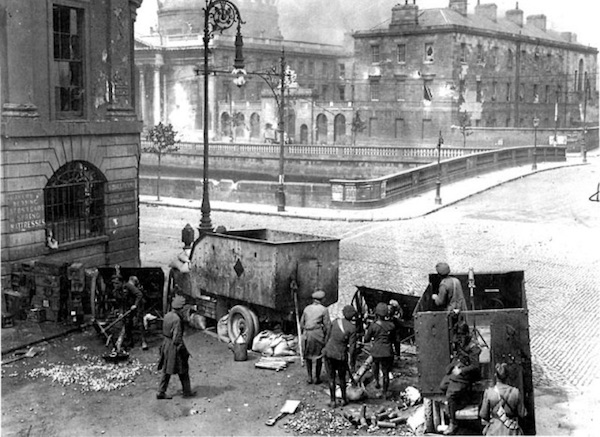
One hundred years ago this week, the IRA occupied the Four Courts in Dublin, Ireland’s most prominent courts building, resulting in a tense stand-off which would come to mark the start of Ireland’s civil war. A historical account by Des Dalton.
Over the course of April 13 and 14, 1922 the IRA occupied the Four Courts and other public buildings in Dublin.
On April 9 the IRA held its reconvened Convention and elected an Executive which in turn elected Liam Lynch as Chief of Staff who then put in place a new GHQ. Staff.
Leading members included Liam Mellows, Rory O’Connor, Ernie O’Malley and Joe McKelvey. On April 13 the Army Council made the decision to occupy the Four Courts, using men from the Third Tipperary Brigade, supported by Cumann na mBan and Na Fianna Éireann.
In his memoir of the Civil War Ernie O’Malley records his memory of the night the occupation took place:
“‘We’re going to take over the Four Courts tonight, he (Liam Mellows) said. ‘We’re going to have a decent headquarters at last. So that’s why the Army Council met this morning, I thought.
“It’s a huge series of buildings, Liam. They will surely attempt to clean us out tomorrow,’ I said. ‘We’ll see,’ he said, and smiled. Some of your Tipperary lads are due to arrive any minute. They will act as a garrison.
“Men from the Dublin Brigade will take the Courts over at midnight.’ We brought the biscuits over to the Gaelic League rooms and waited.
“There were armed men in the halls and in some of the rooms on the first floor. There was an air of suppressed excitement and of gay laughter-something to do at last. I packed up all my papers and tied them into brown paper packets.
‘Are you ready?’ said Liam, as I put on a Sam Browne belt and examined the breech and magazine of my long-barrelled Parabellum. ‘It’s near twelve o’clock now, he said. ‘We’ll move down.’
“We walked along by the footpath near the river, through the dimly-lighted streets. We could see a group of men in one of the lanes off the river. They must be the Dublin men,’ said Liam.
“As we approached the Courts the heavy massive buildings took blurred shapes in the dark ness. The dome could be seen faintly against the sky. We leaned against the parapet opposite to the main gate.
“We approached the main gate. Some stooped down and gave the others a back. They climbed over the railings and disappeared in the dark.
“They’re going to round up the police, I suppose,’ I said. Liam nodded his head. Dublin metropolitan police guarded the buildings which were government property, containing the courts of higher appeal and comprising the headquarters of the legal depart ments. The main building had been designed by James Gandon and was now, together with the Kildare Street Club and the Rotunda, amongst the outstanding edifices in Dublin.
“The city had been ill-fated. Two fine buildings had already been destroyed; the General Post Office had been set on fire by shells during Easter Week, the Custom House had been burnt towards the end of the Tan war.
“The heavy iron gates of the Courts were opened from the inside. Liam and I walked through. Inside in the shadows loomed tall forms, the police, guarded by five youngsters.
“They were told to march outside and go home. They answered our ‘goodnights’ and crunched away. A sound of marching men. ‘What’s that?’ asked Liam. ‘I don’t know,’ I replied; ‘the Tipperary men or the Staters.’
“We waited in the shadows. The marching feet swung in the gate. Forms carrying rifles appeared; they wore no uniform, the Tipperary men had arrived. Guards were posted inside the three entrance gates.
“We moved up and down in the dark, meeting members of our staff, trying to find our way with flash lamps and candles. We went astray in the dark. We got separated and shouted until we heard footsteps or voices. It was a huge area of buildings.
One large block was pointed out by Liam Lynch. “That will be the Headquarters block. You had best select rooms there.”
In her memoir Máire Comerford gave this assessment of those who had taken up occupation of the Four Courts:
“What came to be known as the Executive Forces - the anti-Treaty men, who had occupied the Four Courts - included men I greatly admired; they held that any abandonment of the all-Ireland Republic severed their contract of service, as defined in the Oath for the Republic.”
![[Irish Republican News]](https://republican-news.org/graphics/title_gifs/rn.gif)
![[Irish Republican News]](https://republican-news.org/graphics/title_gifs/harp.gif)

